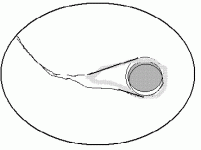V
Valeria101
Guest
Wasn't sure where to start this thread and it ended here just because the answer to the following question seemed likely to come from he farming side.
Here the object:

Now, for anyone who has never looked into pearl nucleation (like myself) that looks like the nacre imprint of a thin, huge sac wrapped around a large round nucleus. Much like a lunch bag with an apple in the bottom.
Detailed images taken from every direction are to be found down the link above the picture.
How can this happen? How come the shape and size of the pearl sac (if that's what it is) is so different from the nucleus. especially with such a large bead involved?
The thing looks so striking, it just begged the question. The nice, tame round ones are so... unproblematic. FleaBay has a way of bringing up these 'pearling exhibits' I wouldn't know what to do with but take them apart and look under the hood
I wouldn't know what to do with but take them apart and look under the hood 
--------------------
PS:Hope the seller doesn't mind this thread - it is definitely meant as a positive comment. Otherwise, I'll be ready to repent and take if off.
Here the object:

Now, for anyone who has never looked into pearl nucleation (like myself) that looks like the nacre imprint of a thin, huge sac wrapped around a large round nucleus. Much like a lunch bag with an apple in the bottom.
Detailed images taken from every direction are to be found down the link above the picture.
How can this happen? How come the shape and size of the pearl sac (if that's what it is) is so different from the nucleus. especially with such a large bead involved?
The thing looks so striking, it just begged the question. The nice, tame round ones are so... unproblematic. FleaBay has a way of bringing up these 'pearling exhibits'
--------------------
PS:Hope the seller doesn't mind this thread - it is definitely meant as a positive comment. Otherwise, I'll be ready to repent and take if off.

